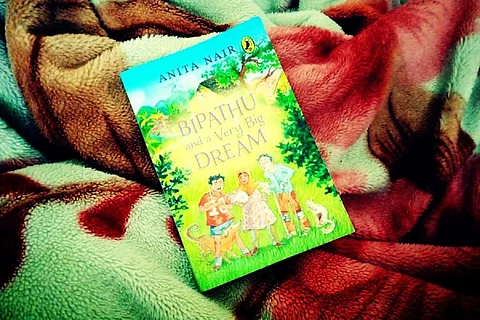

Liking Bipathu is easy. Not because she is a perfect little nine-year-old living in small town Kerala in a book of fiction. It is the opposite. She is full of love and care but, like all children, she also comes with a number of flaws. Anita Nair, the writer of Bipathu and a Very Big Dream, does not make her protagonist an angel of a child. And that only brings you closer to the little girl.
Bipathu lives in Kaikurussi, the same fictional village that Anita had introduced in her first novel, The Better Man in 2000. Kaikurussi showed up again in her 2019 book The Little Duck Girl. The author has retained one of the characters, Maash, from The Little Duck Girl, in Bipathu’s neighbourhood. Bipathu has quite a few favourites like Maash, and Madama, a woman who returns home to Kaikurussi after many years. At home, her elder brother Saad, who has cerebral palsy, is her favourite. Not that Faesal Kutty, the three-year-old younger brother, or Umma, the single parent somehow making ends meet, aren’t loved. Just not as much as Saad or Hrithik Roshan or football, the three things she dreams about every night.
Anita, known for her novels on relationships such as Mistress and Ladies Coupe, is clearly comfortable in the little girl’s world she has created, very much aware of the young readers it is meant for. Long words come hyphenated and Malayalam endearments are adorably thrown in. Bipathu has no qualms declaring she barely knows English. It is somehow comforting, for children across the country have for years been led to believe it is shameful to not know English.
Anita Nair / Facebook
Real world is not exactly blanked out because it is a children’s book. Bipathu’s father, no longer alive, was one of those men so incorrigibly patriarchal that he didn’t like a daughter or a son with disability. He was happy only when Faesal Kutty, the third child, was born, a son and one without disability. Bipathu took beatings for playing with the child’s toy that was denied to her and Saad. Even Umma, when she took over the running of the family, was not exactly the stereotypical picture of motherly love. There was no petting or pampering, only sternness. So much that Bipathy is taken by surprise every time Umma so much as laughs aloud. But you learn to respect her priorities, stretched as she is between a small job and taking care of three little kids. It is not made a big deal of, yet it is clear to see.
Bipathu sees it, she makes no complaints about the chores she has to do or the sacrifices she has to make. She is obedient, as far as possible. But she is not above tweaking the truth to get something she wants. When she wants to stay back for football practice – a place she won hard fighting with the rogue boy Suleiman who argued it is no game for girls – she tells Umma that she has extra classes at school. She also doesn’t bow down before the enemy – Suleiman, school bully and the rich kid on the block – ready to talk back and risk a fight when he crosses limits. Quite a little feminist, Bipathu. And like all children, she can also be unnecessarily mean to a cousin she doesn’t agree with.
Bipathu’s friendships are also of her own liking, not governed by age or gender, as she chooses to spend time with the blind Madama, or Rahul, the new boy in class. Religion is not explicitly mentioned except by way of the madrassa Bipathu goes to or the thattam (hijab) she keeps adjusting. Only in one place she mentions not being able to enter a temple, not as a complaint, just dropping a fact. Anita’s book for children, while keeping to a few formulae such as the brave young protagonist overcoming a difficulty, does not shy away from reality.
Every few pages there are beautiful sketches of the characters and places, the Madama’s front yard and the people and the animals (there is a cat and a dog and a goat), all brought to life by Parmita Mukherjee.